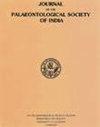Kachchh盆地渐新统碳酸盐岩相分析
IF 0.6
4区 地球科学
Q4 PALEONTOLOGY
Journal of the Palaeontological Society of India
Pub Date : 2023-11-09
DOI:10.1177/05529360231208812
引用次数: 0
摘要
Kachchh盆地位于印度西北边缘。盆地由相对连续的中生代沉积层序组成,接着是德干圈闭,最后是完整的新生代沉积层序。Kachchh盆地新生代沉积以浅海沉积为主,主要有Matanomadh组、Naredi组、Harudi组、Fulra灰岩组和Maniyara Fort组5组。马尼亚拉堡组属于渐新世。研究了高莱河段渐新世灰岩的场域特征和岩相特征,以了解其沉积环境。对马尼亚拉堡组3段(块状粘土段、珊瑚灰岩段和Bermoti段)碳酸盐岩进行岩相学研究,为认识该区沉积相和成岩特征提供了重要信息。块状粘土段为泥质粉砂岩与灰岩互层,其特征是由相当比例的石英碎屑颗粒和一些岩屑组成。岩屑呈亚角到圆形,表明有大量的运输。它们也被磨损和破坏,产生细小的裂缝,这些裂缝被泥晶基质或泥浆填充。在石灰石(虽然不显著)内的花柱缝的存在以及泥浆充填也被注意到。溶蚀作用不明显,表明沉积物埋藏较浅。块状粘土段海洋化石的缺乏和有孔虫的罕见,表明受限制至半限制的浅海环境。珊瑚灰岩段的灰岩在岩石学上可分为包岩、微晶岩和泥岩。因此,沉积环境似乎从有限的泻湖到浅海环境发生了变化。Bermoti成员的特点是粘土岩透镜体,由灰色到黄色的粘土岩与石灰石互层组成。Bermoti灰岩在岩石学上可分为包岩组合、碎屑岩组合和泥岩组合。石灰石被观察到高度微晶化,这表明开放的浅海环境。马尼亚拉堡组以碳酸盐岩的微砾岩-包覆岩-泥岩相为特征,被认为是碳酸盐岩斜坡体系的一部分。马尼亚拉堡组灰岩具有海相和大气成岩作用的特征。本文章由计算机程序翻译,如有差异,请以英文原文为准。
Petrographic analysis of Oligocene carbonates of Kachchh basin
The Kachchh basin is located on the northwestern margin of India. The basin consists of a relatively continuous sequence of sediments from the Mesozoic, followed by the Deccan Traps and finally a complete sequence of the Cenozoic sediments. The Cenozoic sediments of Kachchh basin are mainly shallow marine deposits characterised by five formations viz. Matanomadh, Naredi, Harudi, Fulra Limestone and Maniyara Fort Formation. The Maniyara Fort Formation belongs to the Oligocene age. The field and petrographic characteristics of the Oligocene limestones from the Golay river section were studied in order to understand the depositional environment. The petrographic investigation of the carbonate rocks of three members of the Maniyara Fort Formation, namely Lumpy Clay Member, Coral Limestone Member and Bermoti Member provides important information for understanding the depositional facies and diagenetic signatures. The Lumpy Clay Member has shale-siltstones with interbedded limestones, characteristically composed of a significant proportion of detrital grains of quartz and some lithic fragments. The lithic fragments are sub-angular to rounded, which indicates substantial transport. They are also worn down and broken, bear small cracks which are filled by micritic matrix or mud. The presence of stylolitic seams within the limestone (though not significant) along with mud filling is also noticed. The dissolution is not prominent, pointing towards shallow burial of the sediments. Paucity of marine fossils as well as the rarity of foraminifera in the Lumpy Clay Member indicate a restricted to semi-restricted shallow marine environment. The limestones of the Coral Limestone Member are petrographically classified as packstone, wackestone and mudstone. Thus, the environment of deposition seems to have varied from restricted lagoonal to shallow marine environment. The Bermoti Member is characterised by a lens of claystone, which consists of both greyish to yellow coloured claystones interbedded with limestones. The Bermoti limestones are petrographically classified as packstone, wackestone and mudstone assemblage. The limestones were observed to be highly micritised, which indicates open, shallow marine settings. The Maniyara Fort Formation, thus characterised by wackestone-packstone-mudstone facies of carbonates, is interpreted to be part of a carbonate ramp system. The limestones from Maniyara Fort Formation exhibit signatures of marine as well as meteoric diagenesis.
求助全文
通过发布文献求助,成功后即可免费获取论文全文。
去求助
来源期刊

Journal of the Palaeontological Society of India
PALEONTOLOGY-
CiteScore
1.10
自引率
16.70%
发文量
0
期刊介绍:
The journal is devoted to the publication of original papers and review articles dealing with all aspects of Paleontology, Paleobotany, Stratigraphy, Geochronology, Anthropology and Pre-history.
 求助内容:
求助内容: 应助结果提醒方式:
应助结果提醒方式:


